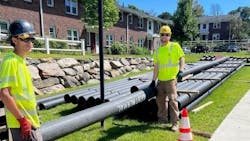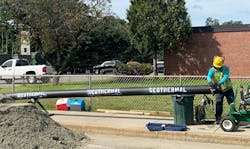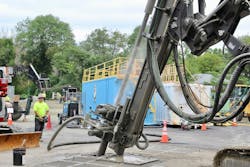Key Highlights
- Government incentives are shifting, with increased support for commercial geothermal projects and large-scale thermal energy networks, creating new opportunities for contractors.
- Consumer demand for sustainable, quiet, and durable heating and cooling solutions is driving adoption, especially in commercial and institutional markets.
- Advancements in affordability and scalability, such as geothermal-ready heat pumps and high-temperature systems, are making geothermal more accessible and cost-effective.
As the HVAC industry continues to evolve toward electrification and decarbonization, geothermal technology is gaining traction, becoming more of a mainstream heating and cooling solution. Once considered a niche market, today’s geothermal systems are being recognized for their unmatched energy efficiency, long-term cost savings, and ability to meet aggressive sustainability goals. To explore what this growing momentum means for contractors, Contracting Business Editor-in-Chief Nicole Krawcke sat down with Jay Egg, president of Egg Geo. In this conversation, Egg explains why geothermal adoption is accelerating, the policy and utility drivers behind it, and how HVAC contractors can position themselves for success in this expanding segment of the market.
CB: How has some of the latest legislation impacted the adoption of renewable HVAC technologies such as geothermal?
JE: The federal government, in one fell swoop, eliminated residential tax credits for wind and solar — and geothermal got lumped in with that. So those 30% residential tax incentives without a cap went away, along with other homeowner credits.
At the same time, they really opened the doors for commercial incentives. Commercial projects still get the 30% tax credit, plus an additional 10% for American-made systems and another 10% if the project is in an energy-poverty community or tribal land. You can reach up to 50% in incentives. They also made it easier for developers to fund large thermal energy networks and systems through power purchase agreements.
If you’re a nonprofit or church, you can even receive a check directly if you don’t have a tax liability. The only way for homeowners to get similar benefits now is if their utility pursues a large-scale program and offers on-bill financing. Otherwise, homeowners would need to form a business entity to qualify.
CB: What is driving consumer demand for renewable energy right now? Is it cost savings, sustainability goals, or new regulations?
JE: There are three main drivers for geothermal adoption. First, it’s become widely accepted as a renewable energy source. The Department of Energy and the current administration have embraced geothermal, from heat pumps to large-scale energy plants.
Second, publicity and visibility have grown. Companies like Dandelion Energy are installing thousands of systems in new Lennar homes, and states like New York, Minnesota, and Texas are developing thermal energy networks.
Finally, geothermal systems are increasingly recognized as the highest-quality option — they’re quiet, last longer, and eliminate outdoor equipment. They’re also more efficient and have strong longevity because the systems are indoors, much like a garage-kept vehicle.
CB: Where are you seeing the most adoption of geothermal — residential, commercial, or institutional?
JE: It’s primarily commercial and institutional. I saw a recent report — though I need to fact-check it — that said more new commercial buildings are being built with geothermal than without. It’s becoming well accepted.
On the residential side, we’re seeing growth mainly in community-scale thermal networks rather than one-off homes. When I lived near Disney, the town of Celebration almost became a fully geothermal community. I tell people that just like natural gas pipelines became widespread, geothermal networks will likely be in place before 2050.
If you can afford it, geothermal pays back within seven to 15 years, depending on your region. But air-source heat pumps remain a good bridge until those networks are more common.
I recently bought a home in North Florida and plan to install a geothermal heat pump myself. Even as a consultant now, I know it will pay back over time, given our climate.
CB: Are there any recent advancements making geothermal systems more efficient or affordable?
JE: Efficiency hasn’t changed much — they’ve always been excellent. The real advancements are in affordability and scalability. Mass adoption through thermal energy networks is driving down costs.
Major manufacturers like Carrier, Bosch, WaterFurnace, and ClimateMaster are fully invested again in geothermal. One exciting innovation comes from WaterFurnace — a temporary external hydronic coil that allows homeowners to install a geothermal-ready heat pump and use it as an air-source unit until the local network becomes available. Then, they can simply connect to the geothermal loop.
On the commercial side, manufacturers are introducing high-temperature geothermal heat pumps that can produce low-energy steam. That’s a major advancement for retrofitting buildings in cities like New York that still rely on steam radiators.
CB: Why should contractors consider offering geothermal installation and maintenance services?
JE: Because it’s where the industry is headed. Fifteen or more states have adopted laws supporting thermal energy networks, and large homebuilders like Lennar are integrating geothermal systems into new communities.
There’s also a big opportunity for electric cooperatives. Many serve suburban and lower-income areas, and they can use on-bill financing to offer geothermal systems to customers. It’s a proven model, but co-ops have been slow to act because they’re busy with daily operations. Still, this could be the next big wave of adoption.
CB: Do you see geothermal becoming mainstream in the U.S. over the next decade?
JE: Yes. It will take more builders following Lennar’s lead and continued investment from state and city governments. Geothermal hasn’t had the same “curb appeal” as visible upgrades, but once consumers better understand the ROI, demand will grow.
When I ran my HVAC contracting business years ago, homeowners would gladly pay $14,000 for marble countertops but wouldn’t spend $1,000 on a higher-efficiency system — even if it paid back quickly. That mindset is slowly changing as education improves.
What excites me most is that geothermal now has bipartisan support. I serve on the board of Geothermal Rising, the world’s largest geothermal organization, and interest is higher than ever. We’re expecting nearly 2,000 attendees at our annual conference this October in Reno — up from 1,300 last year in Hawaii.
There’s even an academic book in development through Elsevier that will cover the full spectrum of geothermal technologies, from residential heat pumps to high-temperature systems, scheduled for release in early 2027.
The Takeaway
As geothermal continues to move from niche to mainstream, HVAC contractors have an opportunity to lead the transition toward cleaner, more efficient building systems. Understanding how incentives, policy changes, and new technologies are reshaping this market can help contractors stay competitive and diversify their service offerings. By staying informed and investing in geothermal expertise now, contractors can position their businesses at the forefront of the industry’s sustainable future.
About the Author

Nicole Krawcke
Nicole Krawcke is the Editor-in-Chief of Contracting Business magazine. With over 10 years of B2B media experience across HVAC, plumbing, and mechanical markets, she has expertise in content creation, digital strategies, and project management. Nicole has more than 15 years of writing and editing experience and holds a bachelor’s degree in Journalism from Michigan State University.



